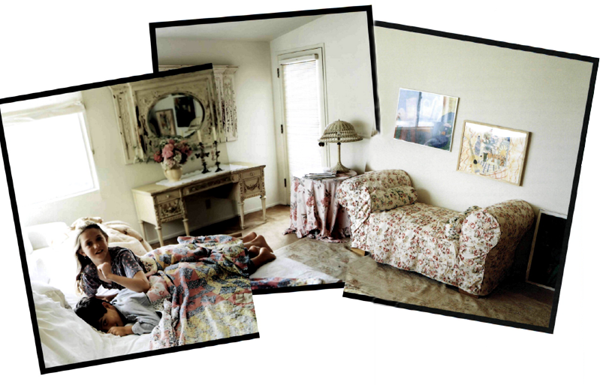
This bedroom is composed of a series of misfit pieces. Nothing quite matches, but everything manages to blend into a comfortable mix of soft creams and pinks. I’ve managed to ignore the crudeness of the Levelor blinds and nylon carpet—aspects that are fixed by virtue of the beach house being a rental—by simply working around them. Children’s artwork is the only wall decor. The daybed, to which I added comfortable neck rolls, does double duty as a refuge for the kids when they wander in in the middle of the night. (See Resource Guide.)
What has is essential to the relaxed, shabby yet chic look, marked by what is comfortable, worn, and often tattered, can be incorporated easily into a variety of decorating styles. A cushy, white slipcovered chair, a casual floral arrangement, a peeling vintage piece, soft lighting, the use of white, and mixed and matched fabrics and textures can look as natural in a sleek, contemporary home as they do in a more traditional setting, such as an eclectic Spanish, French country, or casual beach house. Making the style work is a simple matter of how the elements are put together.
The key to making everything work is to include a balance of complements and contrasts, a display of the effects of time, traces of real life, and a merging of gilt and grit. Anything that appears too contrived or calculated is the antithesis of this look. The Shabby Chic style opts for haphazard arrangements over perfectly symmetrical ones, framed pictures propped against walls rather than hung neatly, and rumpled fabrics rather than pressed finishes.
There are certain floor, wall, and ceiling treatments that I consider to be effective foundations for the Shabby Chic look. Sisal rugs, tile, and hardwood floors, for example, work in formal and casual settings and with a variety of furniture styles, be they traditional or contemporary. White and off-white walls, textured wallpaper, interesting molding treatments, and natural cracks and crumbles can work in almost any style home, as can high, exposed wooden beam or embossed tin ceilings.
While there are certain elements that work with most style homes, such as white slipcovered chairs, there are certain variations that work better for some styles than others. In a high-tech contemporary home, for example, fitted slipcovers may work better with the sleek surroundings than would the loose and roomy look more typical of the Shabby Chic style. Whereas, in a beach house, a casual, more rumpled look blends in better with the overall relaxed mood. Following are some specific examples of how basic elements of the Shabby Chic style, as well as modifications of the look, work in different homes from modern to traditional.

This vintage crystal beaded chandelier, the rumpled silk fabric, rusty white table leg, and slightly withered linen flowers in a tarnished mercury vase all represent the less than perfect look of Shabby Chic.
My rented seafront home is an example of how unchangeable structures can be worked around and strong points (such as picture windows with ocean views) played up. It also shows how pieces with a bit of faded grandeur can add a touch of elegance to a casual beach environment. Because the home is a rental, I did what I could, covering the existing ugly carpets with sisal rugs and adding simple white Roman shades to the windows, while ignoring elements like aluminum window trim, louvered blinds, and unsightly light-switch covers. Because I prefer a subdued look, every room is done in a monochromatic scheme of muted and sun-bleached floral prints. Cushy slipcovered seating is paired with crumbling, painted vintage or wicker furniture. Floral-motif accessories and paintings are combined with wrought-iron chandeliers or wicker lamps. Fresh, but not perfect, garden flowers and my children’s artwork add unique personal touches.
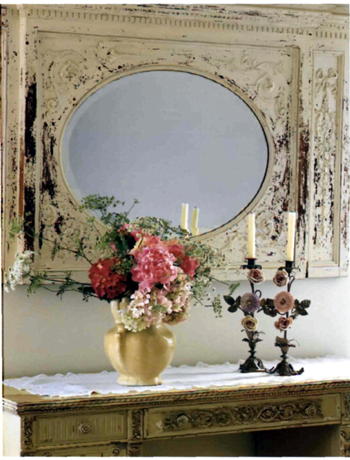
Fine details are crucial indicators of a piece’s quality. The intricate wood-carved detailing on the molding of this old bar mirror belies the frame’s age, marking it with value not easily matched in newer pieces. The play of shapes—an oval mirror in a rectangular frame—adds interest, too. The piece complements the muted mustard sideboard, also characterized by carved detailing. Fresh peonies and porcelain candleholders emphasize the flower carvings and add color.
A delicate blend of different elements—light, fabric, texture, and color—make the difference between a functional corner and a functional yet inviting one. A combination of candles and early morning light imbue this cozy living room alcove in my beach house with a soft tranquillity. The muted seafoam greens, creams, and whites echo the tones of the ocean and sand outside, while wicker, wood, and fabric blur into a harmony of textures. A vintage piece of lace placed over the back of a slipcovered chair hides the inevitable sticky fingerprint left by a child. Sisal rugs cover the drab carpet, and a vintage pitcher and glass decorated with painted flowers offer cool refreshment. (See Resource Guide.)
Flowers—both real and represented—are the unifying theme in the living room of my beach house. Toile candleholders and floral paintings expand upon the mood set by the large and small rose-print fabrics used for the slipcovered sofa and chair. Petals from a fresh arrangement of roses that have fallen to the tabletop are left to stay, adding to the room’s melancholy, peaceful feel. Because the tones are a monochromatic blend of seafoam, sage, olive, and celadon greens and cream, the look is prevented from appearing too busy or romantic. (See Resource Guide.)
In a contemporary home in Venice, California, with its living room of marble, modern shapes, and slick surfaces, an inviting slipcovered sofa and chair break up the starkness and offer warmth. In keeping with the house’s streamlined style, however, the slipcovers are more fitted than the usual Shabby Chic loose and roomy style and can be dry-cleaned rather than laundered to maintain their sleek look. Other worn yet stylish additions that offset the home’s high-tech look are slightly worn vintage pieces and rugged textures, such as an ornate iron gate converted into a coffee table. Quirky antique fixtures and accessories merge the old with the new and give the polished bathroom a less inaccessible feel, as the photos on these pages show.
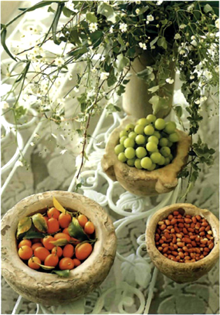
Native American stone bowls echo the granite floors and hard gray walls of this contemporary house. The intricate wrought-iron table salvaged from an old gate lends texture; the flowers, softness; and the fruit, color to the surroundings. (See Resource Guide.)

In sleek, contemporary settings such as this, a touch of the old can add comfort and approachability. In this modern California bathroom, a vintage dentistry cabinet and chemist’s bottles introduce the patina of old textures and shapes to alleviate the starkness. These items are functional, too: The cabinet is used to store stacks of fresh white towels and the bottles to hold shampoos, oils, and lotions. In full view, the contents themselves are objects to be appreciated aesthetically. (See Resource Guide.)
The slipcovered furniture in this modern house adds an element of comfort, but is fitted and modern in shape in keeping with the room’s sleek mood. I also covered the table with a high-gloss white finish and topped it with a sheet of glass rather than let the rust and chips of this iron tabletop show through, as I usually would. (See Resource Guide.)
The Mediterranean-style home of film director Tony Scott and his wife, Donna, though traditional and somewhat formal in style, is made more approachable with the introduction of vintage Italian wall sconces, crackled moldings used as mirror frames, slipcovered furniture (though of a formal fabric and fitted tightly), pillows made from antique textiles, and scuffed wicker. These worn and comfortable pieces merge with the Scott’s collection of formal antiques, lacquered pieces, fine oil paintings, precious rugs, and chandeliers in a way that retains their grandeur while rendering them less pristine. Framed family photographs lend a personal touch, and loose, gardenlike floral bouquets, rather than stiffly composed arrangements, are used to further maintain a relaxed atmosphere.

When decorative objects have no real function other than beauty, an element of whimsy can make surrounding expensive, formal pieces feel more approachable. This delicate Goldscheider bust on the mantel in Tony and Donna Scotts’ formal living room attracted the couple because of its mischievous expression.

Important pieces and formal trappings do not have to make a room feel unlivable. The Scotts’ octagon-shaped living room is filled with precious works of art, a grand piano, nineteenth-century French oil paintings, and an Aubusson carpet, yet it maintains an inviting, comfortable atmosphere. The starkness of the room’s black lacquer pieces is offset by the coziness of slipcovered chairs and sofas, personal photographs, casual flower arrangements, and pillows made of antique textiles. See Resource Guide.)

A subtle touch and cool, restrained tones can prevent a floral motif from becoming overpowering, as is evidenced in the Scotts’ formal guest bedroom. The rose still life hanging above the hand-painted nineteenth-century French bed, covered with a dainty rose print in French chinoiserie embroidered silk, rose details on a pair of antique bedside dressers that have been painted blue, and a set of toile bedside lamps—all combine to create a subdued, delicate treatment that imbues the room with a gentle patina of Old World charm.

Print cushions are a good way to lend comfort—and beauty—to lightweight wicker furniture, which can be used indoors as well as out. The classic white wicker chairs, bench, and table in the Scotts’ shady, bougainvillea-covered garden terrace are a favorite spot.

Flowers bring the freshness of the outdoors into the light, casual entry room of the Scotts’ guest house. The beauty of garden roses and Queen Anne’s lace are complemented by the imperfection of a peeling vase. Along with rose-print curtains and shades, the fresh arrangement softens the harder elements of the room—a scratched wooden table, well-worn wooden chairs, an old grandfather’s clock, and wooden ceiling beams.
Talent manager Sandy Gallin’s Malibu home overlooking the Pacific Ocean has a classic New England-meets-California look. Furnished somewhat formally with dark antiques and dark wood floors, hoards of hard-bound books, handcrafted carpets, formal oil paintings, and a grand piano, the house feels semicasual and inviting due to the predominance of deep, white denim and Marseilles slipcovered chairs and sofas in every room. Gallin and his longtime decorator, Bill Lane, installed these luxurious chairs and couches not only in the living room, den, library, bedroom, and guest house, but in the bathrooms, screening room, and gym, too. “The white slipcovered effect comes from both Sandy’s love of the Hamptons look and also because [the slipcovers] are practical—he lives at the beach and he has three dogs,” says Lane. “Sandy is also very consistent. Not very many people would do every room in their house in the same colors—dark wood, some green velvet, and white furniture, but in this case it absolutely works.” Another presence in every room is Gallin’s flower of choice, orchids, which, while echoing the house’s rather formal atmosphere, bring life, the outdoors, and color into the somewhat monochromatic scheme.

The Malibu home of talent manager Sandy Gallin illustrates how the formal and the traditional can be made more casual for California beach living with the use of roomy chairs and sofas, slipcovers made of white denim, and old Marseilles bedcovers. With the help of his interior designer, Bill Lane, Gallin has created an elegant simplicity, remaining faithful to white throughout, including chairs, sofas, towels, and dishes. The generous use of white also adds light to the dark wood antique furniture.

A corner of the library.

The master bedroom.

Oftentimes, it’s the unexpected that makes the difference between an ordinary room and a spectacular one. Rather than traditional theater seats, Gallin’s screening room has two tiers of plush white denim slipcovered couches. Further personalizing the room is a large photograph of Gallin’s pug dogs, which drops down during screenings to reveal the projection booth, old-fashioned jars filled with candy for guests’ enjoyment, and orchids, which add life and color.
Any home can be transformed to express its owner’s personal statement. Homes that integrate several different looks and reveal their owners’ interests and tastes are tar preferable to homes that appear too planned, look too professionally’ decorated, or where decor is enslaved by theme.
The Spanish-style home of interior stylist Philomena Giusti demonstrates how the cluttered, eclectic look can be successful. Giusti’s house is brimming with examples of new uses for old forms and with items that may seem shabby but have great style, making the formal casual and the casual formal, and bringing the outdoors in. The key is that all of the pieces have character and function, hold special meaning for Giusti, and have been put together in an interesting way.
A peeling Mexican bar is used as a kitchen cabinet, an inexpensive lace curtain as a tablecloth. Chairs are mismatched. Checked fabrics are mixed with florals throughout the house. Old leather armchairs and chipped iron sconces are allowed to proudly flaunt the effects of time and wear. Chandeliers become less imposing when used in the bathroom and garden, and silver less formal when used for a casual snack atop an old wine taster’s table. Rusted patio and wicker furniture, garden plants and statues are brought inside to blur the distinction between indoors and out. The house contains a wealth of personal objects that Giusti has collected over time, including the worn and cracked hands and feet of statues, vintage oil portraits that she rests against the wall rather than hangs, and family photographs displayed in an array of antique frames. “There’s no real rhyme or reason to what’s here or where it’s placed,” says Giusti. “It’s not about what country or which era anything’s from. It’s about what I like, which is pieces with character. And it’s definitely not about matching.”

Though pieces in the casual, comfortable Shabby Chic style are usually as much about function as they are about form, objects without a real purpose that add life or create a distinct mood are desirable, too. This Roman-style statue standing guard over Philomena Giusti’s front rose garden sets a gentle, welcoming tone.

In the living room of Giusti’s Spanish-style home a cushy antique red sofa adds a shock of color, an antique zebra rug lends a note of old-world whimsy, and a worn leather chair with a velvet cushion offers a cozy corner to relax in. Eighteenth-century Italian angels tucked into niches over the fireplace stand guard over the room, along with oil paintings of women dating from the twenties and thirties that Giusti believes resemble her mother and sister. A scattering of plants and fresh roses from the garden bring the outdoors in.
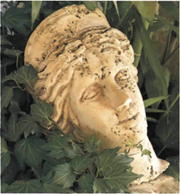
This weathered head from a garden statue, which rests peacefully in a planter inside Philomena Giusti’s living room, illustrates how pieces meant for the outdoors can work just as well indoors.

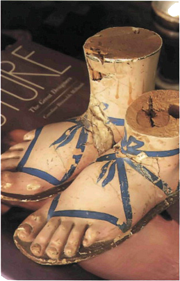
TOP AND ABOVE: Objects that show the ravages of time have their own beauty, and parts of an object can be as attractive as the whole. The delicacy and sense of decay of this broken hand and pair of tiny chipped feet from an antique statue attracted Giusti.

Eating in the kitchen used to be a practice reserved for servants and children, but this room is now considered a favorite place for informal gatherings in many homes. The colorful food, bright sunflowers, and mismatched plates and napkins add to the eclectic, friendly clutter of Giusti’s kitchen. A toile chandelier from the forties sheds soft light on a worn farmer’s table surrounded by stools covered in a vintage vegetable-print fabric. In the background, a decaying green cabinet houses neatly stacked dishes, while a floral pillow blends easily with a casual red and white striped wooden chair.
The eclectic Topanga Canyon home of Chantall Cloutier, owner of the hair, makeup, and style agency by her name, also incorporates some basics of the Shabby Chic style. In this case, white walls, white slipcovered chairs and couches, and a coffee table fashioned from a vintage door painted white all serve as backdrops for Cloutier’s plush velvet throws, pillows, and curtains in deep jewel tones. The introduction of white prevents the richness of the rest or the furnishings from becoming overbearing. “I love white,” says Cloutier. “It’s so versatile. A different color couch wouldn’t allow me to make changes as easily and I’m constantly changing and rearranging.”
Cloutier allows the style of her house to evoke, adding and subtracting pieces she collects at flea markets, auctions, and vintage and antique shops. Her somewhat theatrical bathroom illustrates how-merging the formal with the casual and using the element of surprise can transform a room into something that is unpredictable yet comfortable and functional. Mirrors are used to create the illusion of more space. An overstuffed, slipcovered armchair and Turkish rugs helped turn the area into a plush sitting room of sorts. A bust, oil paintings, and a gilded towel rack made from a vintage pedestal—all picked up at flea markets—are whimsical yet formal additions that enhance the room’s unique feel. Throughout the house are many windows that Cloutier had installed to lighten the look of her gilded mirrors and frames, columns, and dark fabrics.
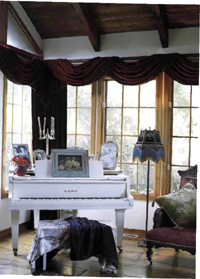
An old theater curtain in burgundy velvet draped in loose swags lends formality to this eclectic corner in Chantall Cloutier’s home. The stark white piano is offset by the dark velvets of the antique chair, blue pillow, piano bench cover, curtains, and custom-made lamp shade. An array of personal objects—silver frames, a mirror, floral painting, red roses, and a candelabrum—carry through the theatrical theme.

Cloutier’s home office is luxurious vet very functional. The ornate, carved wooden desk is made from an old table topped with glass. The bookends are a new use for rose-motif fireplace andirons. The lamps, flea market finds, have custom-made lamp shades. The vintage carved wooden mirror creates a sense of light and space.

The Topanga Canyon bathroom exemplifies the idea of creating the unexpected. Five mirrors, several windows, and French doors leading to a garden add to the spacious feeling of this already large bathroom, where Cloutier created an indoor-outdoor mood. An overstuffed armchair made from different tablecloths sewn together, an angel towel rack, and reproduction Turkish rugs transform the space into an almost luxurious sitting room. Tiled floors, walls, and door trim add an aesthetic as well as a practical touch.
Time-worn furniture, crinkled fabrics, muted colors, and Imperfect chandeliers or tracked paintings may be the mainstays of Shabby Chic decor, but before combining them to create an overall ambiance for a room, there are other, more basic components to be dealt with. The structure of the room itself, in the form of its floors, walls, and ceilings all need to be considered before, or at least in conjunction with, tackling its contents. The following section points out which of these elemental Components blends best with the kinds of pieces that define the Shabby Chic style, whatever the architectural style of the house.
Floor, wall, and ceiling treatments are the basis of every home’s style and ambiance. These three components are often noticed on a more subtle rather than overt level, but they create a world of difference in setting an atmosphere. The contrast between a hardwood floor and wall-to-wall carpeting, paneled and clean white walls, and high and low ceilings illustrates how vital these basic elements are to a room. The wav they are treated makes a vast difference as to whether they will serve as backdrops or lake a more active role in a room’s actual appeal.
Although floor, wall, and ceiling treatments can be done after a room’s fabrics, furniture, and accessories have been selected, I find that using these three surfaces as a starting point is the easiest way to go about decorating a home.
FLOORS
When it comes to floors, I believe first and foremost in simplicity of look and ease of care. Floor coverings that create the most relaxed yet classic appearance include hardwood floors, sisal rugs, variations of Spanish or Mexican tile, and sandblasted cement, floor coverings might set up a pleasing contrast with the rest of the house’s look, for example a sisal rug in a formal living room lends a touch of the casual. Or a floor may act as a complement to the surroundings, as a sandblasted cement floor would in a very modern home. These floorings also work best with the furniture and fabrics I prefer.
Hardwood floors work with almost any style furniture and are relatively easy to keep clean. Hardwood is generally more expensive than carpeting, typically costing six to thirty dollars per square foot, depending on the wood. Preassembled hardwood floors that are glued down are slightly less expensive, costing about five dollars per square foot, but they are less flexible in terms of sanding, sealing, and staining. In some cases, you may want to put down a waterproof barrier between your hardwood covering and the floor—a professional can give you advice. I also like to add throw rugs to hardwood environments, as the additional color and pattern create a cozy appeal.
Sisal rugs have become increasingly popular. Made of natural root fibers woven in a ropelike fashion, they tend to give rooms a casual, almost indoor-outdoor feel. Most sisals are bound by rubber and backed by latex to make them more cushiony.
The tricky thing about sisals is that they’re not that simple to care for. They absorb spills quickly and can easily ravel and pull. They also come in bolts that are typically twelve feet wide, so if a room is wider than this, other strips of sisal need to be added carefully along the sides to make the seams invisible.
Tiles, referred to by professionals as pavers, are great choices for kitchens, entryways, and bathrooms, but they also work well in dining and living rooms. Terra-cotta tiles in nine- to twelve-inch squares are relatively inexpensive. Fancier, imported tiles are much costlier, and marble even costlier, depending on its quality. Typically, a mudpack—a base of roofing paper, chicken wire, then mortar or cement—needs to be laid down as a foundation for tile. This should be done professionally.
Sandblasted cement has become a common floor covering choice for many modern retailers. I used sandblasted cement in my Santa Monica shop because I like the cool patina it emanates, but it can also work well in residential situations. Sandblasting is a process that removes the creamy top layering of a cement floor to expose the rougher, sandy layer just below the surface, creating a textured appeal. Sandblasting machines can be easily rented, but keep in mind that the wear and tear that sandblasting can put on a house is tremendous. Every thing must be removed, and walls and windows must be carefully protected with thick blankets.
WALLS
White walls are the most classic, clean foundations for any room. Acting as a sort of blank canvas, white complements and contrasts with a variety of colors, tones, and textures and serves well as a backdrop for all styles of furniture. Pure white, however, can stark so I prefer off-whites, eggshells, ivories, and creams. I often paint wall trimmings in a slightly different hue from the rest of the wall so that they stand out.
Like the humble appeal of a dresser with peeling paint or a leather chair with worn patches, imperfections in walls can be beautiful. Before rushing to cover natural cracks or crumbles with plaster or paint, take a good look at any flaws to discern whether they add charm and character.
Treatments such as wainscoting or anaglypta wallpaper (an embossed paper with a raised pattern) are other ways I like to add detailing to walls. These particular details tend to work best in homes that are traditional or old-fashioned in mood rather than in sleek, contemporary ones. In bathrooms, kitchens, and dining rooms, tongue-and-groove wood slats (they fit together like puzzle pieces) that extend from floor to chair height add texture. The slats are also functional, protecting the wall from banging chairs. When finished in high-gloss paint, wainscoting is easier to wash than regular walls. I installed a wainscoting of tongue-and-groove slats in my old bathroom for just these reasons.
Anaglypta adds texture and detail to a wall without overpowering it. Though it is applied like wallpaper, true anaglypta comes only in white and without a finished surface. Anaglypta must be painted (even if you repaint it white), otherwise spills will seep right through. As with wainscoting, I use semi- or high-gloss paint on anaglypta because it’s very washable. Anaglypta is most often used for only the bottom half of a wall and is typically separated from the painted top portion by a chair rail or wood molding (I prefer moldings at least three inches thick to create a stronger demarcation). Some types of anaglypta can be purchased for as little as twelve dollars for a twenty- to twenty-to twenty-five square-foot roll.

This anaglypta wallpaper shows how a plain wall can become decorative in and of itself rather than simply serve as a backdrop for other pieces. Anaglypta—or embossed paper with a raised pattern—common at the turn of the century, can still be found at better wallpaper stores.
Wall and ceiling trimmings such as crown moldings (used at the junction of wall and ceiling), friezes (a band just under the crown molding), and other architectural ornaments can also be lovely decorative additions to a room. Most lumberyards offer a variety of standard wall moldings, but outlets specializing in architectural ornaments that look like carved wooden or plaster relief but are actually a special type of claylike dough offer a more interesting variety. Shaped and molded with heat and water, these ornaments are then steamed and bonded to a surface. They can also he glued with regular white glue to wood, metal, plaster, paint, or wallpaper, but steaming creates a better bonding effect. This little-known process dates back to sixteenth-century Italy, and the ornaments, referred to as composition ornaments, or compos, are common sights in elegant old hotels, theaters, and grand estates.
Composition ornaments are available in hundreds of different patterns, from columns, curves, and swirls to fleurs de lis, flowers, lions, urns, and cupids. The ornaments can be used as trim for walls, windows, floors edges, and ceilings as well as on furniture and fireplaces. Though I prefer original carvings on furniture rather than additions, compo has the ability to blend in easily as part of a piece and is more detailed than newer wood carvings. (I have occasionally used new compo pieces to add detailing to mirrors and frames.) Because it is semiperishable and becomes brittle over time, compo should be used no later than a month after it is ordered—the fresher it is when used, the better.
CEILINGS
High ceilings, especially those of exposed wood or wooden beams, while not always possible to achieve are my choice for every style of home. But even if a room doesn’t have a high ceiling, you can turn what exists into something more than an overhead covering and make it a prominent part of the decor of the space. Detailing such as medallions and rosettes—architectural ornaments that hold or surround light fixtures—and other trims are the types of touches that make a ceiling noticeable.

Stamped tin ceilings, which were very common at the turn of the century, are making a comeback. This one, at my Santa Monica store, is intricately detailed and was placed together piece by piece. Though expensive (this ceiling, which covers a three-thousand-square-foot area, cost four thousand dollars for materials and an additional four thousand dollars for installation), they come in a variety of patterns and completely transform a plain room into something grand.
My favorite way to make a ceiling into something really special is to cover it with sheets of embossed or stamped tin. Common at the turn of the century and still found in old country stores, courthouses, and other buildings, embossed or stamped tin can still be purchased from a few outlets that have been in the business for years (see Resource Guide). Though expensive, tin ceilings, with their intricate designs, are truly beautiful. While you can hang tin ceilings yourself for about half the cost of having a professional do it for you, it’s a complicated process requiring the installation of a dropped grid or acoustic framework. This is why I highly recommend using a professional contractor. Once installed, the ceiling needs to be painted. I use a pale color such as cream or mint green to prevent the ceiling from seeming too heavy. Whether sisal rug or hardwood floor, plain white walls or embossed wallpaper, wooden beam or tin ceiling, the unifying characteristic of environments that work best with comfortable and worn Shabby Chic decor is simplicity. While floors, walls, and ceilings can certainly be interesting in their own right, I look at them more as backdrops to highlight a room’s pieces. Overly decorated, colorful, or patterned structures not only detract from the interior furnishings of a room, but they also have less versatility and longevity. Neutral colors and plain or subtle textures have a longer lifespan and blend easily with any style home or specific space—living room, bathroom, or bedroom.
The next chapter addresses the particulars of these rooms from the functional to the aesthetic and explains how different approaches can be taken to imbue them with a Shabby Chic ambiance beyond floor, wall, and ceiling.